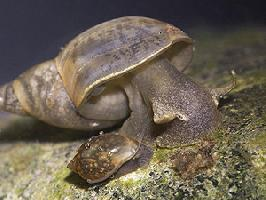
Popis zvířete
The Pond mud snail, scientifically known as Omphiscola glabra, is a distinctive species of air-breathing freshwater snail, belonging to the family Lymnaeidae, which encompasses a wide variety of aquatic pulmonate gastropods. This intriguing mollusk is characterized by its ability to thrive in a variety of freshwater habitats, most notably in ponds, slow-moving streams, and marshes, where it plays a crucial role in the ecosystem.Physically, the Pond mud snail is recognized by its dextrally coiled shell, which exhibits a smooth texture and a glossy appearance. The shell's color can range from light brown to a more muted greenish hue, blending seamlessly with the muddy or sandy bottoms of its natural habitats. This cryptic coloration serves as an effective camouflage, protecting it from predators. The shell typically measures between 15 to 30 millimeters in height, with a proportionately slender and elongated shape that tapers to a pointed apex. The aperture of the shell is relatively large and oval-shaped, facilitating easy movement and respiration for the snail.
The diet of the Pond mud snail is omnivorous, consisting of decaying organic matter, algae, and sometimes small invertebrates. This dietary flexibility allows it to adapt to varying conditions and contributes to its role as a key species in nutrient cycling within aquatic ecosystems. By feeding on detritus and algae, it helps to control algal blooms and maintain water quality.
Reproduction in Omphiscola glabra is hermaphroditic, meaning each individual possesses both male and female reproductive organs. However, cross-fertilization between two individuals is generally preferred. The snails lay eggs in gelatinous clusters attached to aquatic vegetation or submerged objects, ensuring the next generation's survival. The eggs hatch into free-swimming larvae, which eventually settle and metamorphose into juvenile snails, continuing the life cycle.
The Pond mud snail is considered to be of conservation interest in several regions due to its sensitivity to water pollution and habitat destruction. As such, it serves as an indicator species for assessing the health of freshwater ecosystems. Despite facing threats from water pollution, habitat loss, and the introduction of invasive species, Omphiscola glabra has demonstrated a remarkable resilience, though its populations are monitored to prevent significant declines.
In summary, the Pond mud snail (Omphiscola glabra) is a fascinating and ecologically significant freshwater snail. Its presence in an aquatic ecosystem is indicative of water quality and the overall health of the environment. Through its unique adaptations, dietary habits, and reproductive strategies, this species contributes to the biodiversity and functioning of freshwater habitats, underscoring the importance of conserving such ecosystems for future generations.
Podobná zvířata
Nové fotografie zvířat
Top 10 zvířat
- Dolphin gull (Leucophaeus scoresbii)
- Diana monkey (Cercopithecus diana)
- Moustached guenon (Cercopithecus cephus)
- Galápagos tortoise (Geochelone nigra complex)
- Stone loach (Barbatula barbatula)
- Japanese macaque (Macaca fuscata)
- Russian tortoise (Testudo horsfieldii)
- Greek tortoise (Testudo graeca)
- Common flying dragon (Draco volans)
- Vendace (Coregonus albula)
